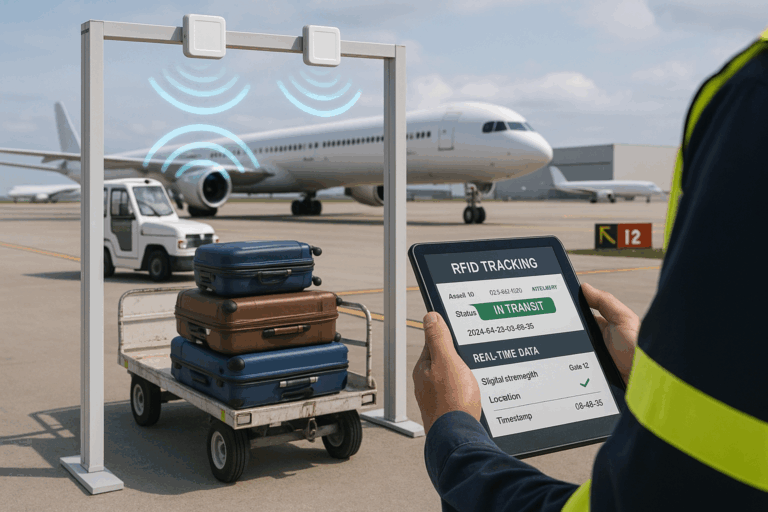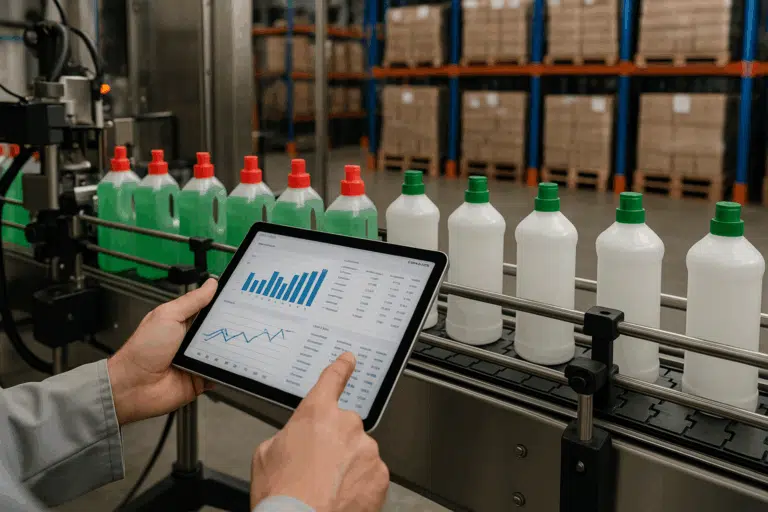Enterprise RFID solutions have revolutionized the way businesses manage and track their assets, inventory, and supply chains.
RFID technology utilizes small electronic tags that can be attached to objects or embedded in products, enabling them to be identified and tracked remotely using radio waves.
With enterprise RFID solutions, organizations can gain real-time visibility and accurate data about their assets’ location, movement, and status, resulting in improved operational efficiency, enhanced inventory management, reduced losses, and increased productivity.
By harnessing the power of RFID, businesses can streamline their processes, optimize their supply chains, and achieve greater visibility and control over their operations, ultimately leading to improved customer satisfaction and profitability.
Table of Contents
ToggleUnderstanding RFID Technology
What is RFID and how it works?

RFID (Radio Frequency Identification) is a technology that enables the wireless identification and tracking of objects using electromagnetic fields. It consists of two main components: RFID tags and RFID readers.
The tags, also known as transponders, are small electronic devices that contain a unique identifier and can store additional data. These tags can be attached to or embedded in objects, such as products, assets, or inventory.
RFID readers emit radio waves that activate the tags within their range and capture the data stored in them.
This information is then transmitted to a central system for processing and analysis. RFID technology offers numerous benefits, including automated identification, real-time tracking, improved inventory management, enhanced supply chain visibility, and increased operational efficiency across various industries.
The Importance of Enterprise RFID Solutions
Enterprise RFID solutions play a crucial role in modern businesses by offering a multitude of benefits and addressing various operational challenges.
These solutions provide organizations with real-time visibility and accurate data about their assets, inventory, and supply chains, enabling improved operational efficiency and streamlined processes.
By leveraging RFID technology, businesses can enhance inventory management, reduce losses, optimize supply chain operations, and increase productivity.
RFID solutions empower organizations with the ability to track and locate assets with ease, automate data capture, minimize human errors, and improve overall operational transparency.
Moreover, the increased visibility and control over operations afforded by RFID solutions lead to enhanced customer satisfaction, reduced costs, and increased profitability. In today’s competitive business landscape, implementing enterprise RFID solutions has become increasingly important to drive operational excellence and gain a competitive edge.
Asset Tracking and Management
Asset tracking and management form a vital component of enterprise RFID solutions, revolutionizing how businesses monitor and control their valuable resources.
By attaching RFID tags to assets, such as equipment, machinery, vehicles, or high-value items, organizations can gain real-time visibility and accurate insights into their location, movement, and status.
RFID readers deployed strategically across facilities or supply chains can automatically detect and capture asset data, eliminating the need for manual tracking and reducing human errors.
This enables organizations to track asset utilization, streamline maintenance schedules, prevent loss or theft, optimize resource allocation, and improve overall operational efficiency.
With the ability to access up-to-date information on asset location and availability, businesses can make informed decisions, minimize downtime, enhance productivity, and reduce costs associated with misplaced or underutilized assets.
Ultimately, asset tracking and management in enterprise RFID solutions empower organizations to maximize their asset utilization, improve operational performance, and drive tangible business outcomes.
Access Control and Security
Access control and security are critical aspects addressed by enterprise RFID solutions, offering enhanced protection and streamlined management of physical access to facilities, sensitive areas, or digital systems.
RFID technology enables the implementation of secure and efficient access control systems by utilizing RFID cards or badges embedded with unique identifiers. These identifiers are linked to user profiles, granting or denying access based on pre-defined permissions.
RFID readers positioned at entry points or checkpoints authenticate the credentials of individuals by detecting and validating their RFID tags or cards. This automated process eliminates the need for manual verification, improves operational efficiency, and minimizes the risk of unauthorized access.
Additionally, RFID-based access control systems can provide real-time visibility and generate audit trails, enabling organizations to monitor and track individuals’ movements, enhance security protocols, and quickly identify any breaches or anomalies.
The integration of enterprise RFID solutions in access control enhances security measures, safeguards sensitive areas, and ensures a robust and efficient control mechanism within the organization.
Supply Chain Management
Supply chain management is greatly transformed by the implementation of enterprise RFID solutions, revolutionizing the way businesses track, monitor, and optimize their supply chains.
By tagging products, pallets, or containers with RFID tags, organizations gain real-time visibility into the movement and location of goods throughout the supply chain.
RFID readers placed at various checkpoints or warehouses automatically capture data, enabling accurate inventory tracking, reducing manual errors, and improving overall inventory management.
This level of visibility allows for improved demand forecasting, streamlined logistics, enhanced order fulfillment, and reduced stockouts or overstocks. Additionally, RFID technology enables businesses to track and trace products, ensuring compliance with regulations, enhancing product authentication, and enabling efficient recall management when necessary.
The integration of enterprise RFID solutions in supply chain management enhances efficiency, reduces costs, minimizes errors, and ultimately leads to improved customer satisfaction and increased profitability.
Key Components of Enterprise RFID Solutions
Enterprise RFID solutions consist of several key components that work together to enable efficient and effective RFID implementation. The first component is RFID tags or transponders, which are attached to or embedded in objects to be tracked and identified.
These tags contain a unique identifier and can store additional data. The second component is RFID readers or interrogators, which emit radio waves and capture the information transmitted by the RFID tags.
The readers are responsible for communicating with the tags and extracting the data stored in them. The third component is the backend software or system, which receives and processes the data captured by the readers.
This system manages the RFID infrastructure, interprets the collected information, and integrates it with other enterprise systems for analysis and decision-making. Additionally, the RFID infrastructure includes antennas, which facilitate the communication between the tags and readers, and a network infrastructure for transmitting data.
The combination of these key components forms the foundation of enterprise RFID solutions, enabling businesses to track and manage assets, inventory, access control, and supply chains efficiently.
RFID Hardware: Readers, Antennas, and Tags
RFID hardware components, including readers, antennas, and tags, are integral to the successful implementation of enterprise RFID solutions.
RFID readers, also known as interrogators, are devices that emit radio waves and receive signals from RFID tags.
They capture the unique identifiers and data stored in the tags and transmit this information to the backend system for processing.
Antennas play a crucial role in establishing communication between readers and tags by generating electromagnetic fields and receiving the tag’s response signals. They are responsible for ensuring efficient and reliable data capture from tags within their range.
RFID tags are electronic devices that contain a unique identifier and sometimes additional data. They can be attached to or embedded in objects and are powered by the energy received from the reader’s radio waves.
These tags transmit their stored information back to the reader when activated. In enterprise RFID solutions, the selection of appropriate readers, antennas, and tags is critical to ensure reliable and accurate data capture, enabling businesses to achieve efficient asset tracking, inventory management, and supply chain optimization.
RFID Software: Data Management and Analysis
RFID software plays a vital role in enterprise RFID solutions by enabling effective data management and analysis. This software encompasses various components, including middleware, database systems, and analytics tools.
Middleware acts as a bridge between the RFID readers and the backend systems, facilitating the seamless integration and transmission of data. It manages the flow of information, filters and formats the collected data, and ensures its compatibility with existing enterprise systems.
The database systems store and organize the captured RFID data, allowing for efficient retrieval and access. They enable businesses to maintain a centralized repository of RFID-related information and support advanced queries and reporting.
Analytics tools leverage the stored data to provide actionable insights, trends, and performance indicators, empowering organizations to make informed decisions and optimize their operations.
By leveraging RFID software for data management and analysis, enterprises can unlock the full potential of RFID technology and derive valuable business intelligence from their RFID deployments.
RFID Implementation: Installation and Integration
RFID implementation in enterprise solutions involves installation and integration processes to ensure seamless deployment and integration with existing systems.
The installation phase includes strategically placing RFID readers and antennas at appropriate locations within the facility or along the supply chain to capture data effectively. This involves assessing the optimal reader placement, considering factors such as coverage area, signal strength, and interference mitigation.
Integration entails connecting the RFID infrastructure with the organization’s backend systems, such as inventory management or enterprise resource planning (ERP) systems.
This integration ensures that the captured RFID data is seamlessly transferred and synchronized with the existing data ecosystem, enabling real-time visibility and streamlined operations.
Successful RFID implementation requires careful planning, collaboration with vendors, and coordination with internal IT teams to ensure smooth installation and integration processes, ultimately leading to enhanced asset tracking, inventory management, and operational efficiency.
Choosing the Right Enterprise RFID Solutions Provider
Choosing the right enterprise RFID solutions provider is a crucial decision that can greatly impact the success of RFID implementation. When selecting a provider, organizations should consider several key factors. First and foremost, expertise and experience in RFID technology are paramount.
The provider should have a proven track record in designing and implementing RFID solutions across diverse industries.
Additionally, the provider should offer a comprehensive range of RFID hardware, software, and services tailored to the specific needs of the business.
This includes RFID readers, antennas, tags, middleware, and analytics tools. Moreover, the provider should demonstrate a commitment to understanding the unique requirements and challenges of the organization and provide customized solutions that align with their goals.
Additionally, factors such as post-implementation support, scalability, and a strong reputation for reliability and customer satisfaction should be taken into account. By carefully evaluating and selecting the right RFID solutions provider, organizations can ensure a successful RFID implementation and maximize the benefits of this transformative technology.
Factors to Consider When Choosing a Provider
Choosing the right provider for enterprise RFID solutions requires careful consideration of various factors. Firstly, expertise and experience in RFID technology should be assessed to ensure the provider has a strong track record in designing and implementing successful RFID solutions.
Additionally, it is important to evaluate the provider’s ability to offer a comprehensive range of RFID hardware, software, and services that cater to the specific needs of the business.
The provider’s capability to offer seamless integration with existing systems, scalability for future growth, and reliable post-implementation support are crucial aspects to consider.
Furthermore, factors such as data security measures, compliance with industry standards, and a strong reputation for customer satisfaction should be taken into account.
Conducting thorough evaluations, requesting references and case studies, and engaging in detailed discussions with potential providers will enable organizations to make an informed decision and choose a reliable partner for their enterprise RFID solution needs.
Top Enterprise RFID Solutions Providers
Several top enterprise RFID solutions providers have established themselves as leaders in the industry. One of these providers is Impinj, known for their comprehensive RFID platform that includes high-performance readers, antennas, and tags.
They offer solutions for various industries, enabling efficient asset tracking, inventory management, and supply chain optimization. Another leading provider is Zebra Technologies, offering a wide range of RFID solutions, including readers, printers, and software applications.
Their solutions cater to different sectors such as retail, healthcare, and transportation, delivering enhanced visibility and operational efficiency.
Honeywell, a prominent player, provides a diverse portfolio of RFID products, including readers, tags, and software solutions, empowering businesses to streamline operations and improve productivity.
Additionally, Avery Dennison is recognized for their innovative RFID solutions, particularly in the retail and apparel sectors, enabling inventory accuracy, enhanced customer experiences, and brand protection.
These top providers exemplify excellence in delivering robust and effective enterprise RFID solutions that meet the needs of businesses across various industries.
Implementing Enterprise RFID Solutions: A Step-by-Step Guide
Assessing Your Needs
Assessing your needs is a critical step when implementing enterprise RFID solutions. Begin by identifying the specific challenges or pain points in your operations that RFID can address, such as inefficient inventory management or lack of visibility in the supply chain.
Determine your objectives and desired outcomes, whether it’s improving asset tracking accuracy, enhancing operational efficiency, or streamlining processes.
Evaluate the scale of implementation, considering the number of assets or products to be tagged and the areas or departments where RFID will be deployed.
Assess the compatibility of RFID with your existing systems and infrastructure, ensuring seamless integration. Additionally, consider factors like budget, timeline, and resource availability.
By thoroughly assessing your needs, you can tailor the RFID solution to your unique requirements and maximize its benefits for your organization.
Choosing the Right Hardware and Software
Choosing the right hardware and software is crucial when implementing enterprise RFID solutions. For hardware, consider factors such as the performance and reliability of RFID readers, the coverage and range of antennas, and the durability and compatibility of RFID tags with your assets or products.
Select hardware that meets your specific requirements, whether it’s high-volume scanning, rugged environments, or integration with existing infrastructure.
When it comes to software, look for a comprehensive RFID software platform that offers features like data management, real-time visibility, analytics, and integration capabilities with your backend systems.
Consider the user-friendliness and scalability of the software, as well as the availability of support and updates. By carefully selecting the right hardware and software components, you can ensure a seamless implementation and maximize the value and effectiveness of your enterprise RFID solution.
Installation and Integration
Installation and integration are critical steps in the successful implementation of enterprise RFID solutions. During installation, RFID readers and antennas need to be strategically placed to ensure optimal coverage and effective data capture.
Careful consideration should be given to factors like signal strength, interference mitigation, and reader positioning. Additionally, the proper attachment or embedding of RFID tags on assets or products is crucial.
Integration involves connecting the RFID infrastructure with existing systems, such as inventory management or enterprise resource planning (ERP) systems. This integration enables seamless data transfer and synchronization, ensuring that RFID data seamlessly flows into the organization’s backend systems for real-time visibility and streamlined operations.
Successful installation and integration require coordination with internal IT teams, collaboration with RFID solution providers, and thorough testing to ensure a smooth and efficient implementation of the enterprise RFID solution.
Training and Support
Training and support are vital aspects to consider when implementing enterprise RFID solutions. It is essential to provide comprehensive training to employees who will be using the RFID system, ensuring they understand its functionalities, benefits, and how to operate it effectively. Training should cover topics such as tag handling, reader operation, data interpretation, and troubleshooting.
Additionally, ongoing support is crucial to address any issues or questions that may arise after implementation. A reliable RFID solutions provider should offer timely support, including troubleshooting assistance, software updates, and maintenance services.
Regular communication with the provider and access to a knowledge base or support portal can help ensure a smooth transition and efficient operation of the RFID solution.
By investing in proper training and securing reliable support, organizations can optimize the use of their RFID system and mitigate any potential challenges or disruptions.
The Future of Enterprise RFID Solutions
The future of enterprise RFID solutions is poised for exciting advancements and expanded applications. With the continuous evolution of technology, RFID systems are expected to become even more versatile, scalable, and efficient.
Improved integration capabilities will enable seamless interoperability with other emerging technologies such as IoT, AI, and cloud computing, unlocking new opportunities for data analytics, automation, and enhanced supply chain visibility.
Miniaturization of RFID tags will enable their integration into smaller objects and enable new use cases in sectors like healthcare, retail, and logistics.
Moreover, advancements in battery-less and energy-harvesting RFID technology will reduce maintenance requirements and enhance sustainability.
As the demand for real-time, accurate data increases, enterprise RFID solutions will continue to play a vital role in optimizing operations, improving customer experiences, and driving innovation across various industries.
Emerging Trends in RFID Technology
RFID technology is undergoing exciting advancements, leading to emerging trends that are shaping its future applications. One significant trend is the integration of RFID with other technologies such as Internet of Things (IoT) and artificial intelligence (AI), enabling the creation of smart and interconnected systems.
This integration allows for real-time data collection, analysis, and decision-making, leading to improved efficiency and automation in various industries. Another trend is the development of RFID sensors capable of capturing additional data beyond identification, such as temperature, humidity, or pressure.
These sensor-based RFID solutions enable advanced monitoring and quality control in sectors like healthcare, logistics, and agriculture.
Additionally, advancements in printable and flexible RFID tags are enabling their integration into diverse form factors, leading to innovative applications in areas like wearable technology, packaging, and product authentication. As these trends continue to evolve, RFID technology is poised to revolutionize processes, enhance visibility, and drive transformative changes across industries.
The Role of RFID in the Internet of Things (IoT)
RFID plays a vital role in the Internet of Things (IoT) ecosystem by providing a means to identify, track, and communicate with objects in the physical world.
As IoT devices become more interconnected, RFID acts as a foundational technology for capturing real-time data from tagged objects. RFID tags, when integrated with IoT systems, enable seamless identification and tracking of assets, products, and inventory across various industries. The data captured by RFID tags can be used to trigger automated actions, monitor supply chain operations, optimize inventory management, and enhance asset tracking.
By leveraging RFID within the IoT framework, businesses can gain unprecedented visibility, automate processes, and make informed decisions based on accurate and timely data, leading to improved operational efficiency, enhanced customer experiences, and new opportunities for innovation.
Conclusion
In conclusion, understanding RFID technology and its significance in enterprise settings is crucial for organizations seeking to enhance their operations.
Enterprise RFID solutions offer a wide range of benefits, including improved asset tracking, inventory management, access control, and supply chain optimization. Key components of these solutions, such as RFID tags, readers, and software, work together to enable efficient data capture, management, and analysis.
Choosing the right provider is vital, considering their expertise, product offerings, and post-implementation support. Implementing enterprise RFID solutions requires careful planning, installation, and integration to ensure seamless deployment and integration with existing systems.
Looking ahead, the future of RFID technology holds promising advancements, including integration with IoT, sensor-based solutions, and innovative applications. By following a step-by-step guide and considering emerging trends, organizations can maximize the potential of RFID and drive operational excellence in the ever-evolving business landscape.
Frequently Asked Questions (FAQs)
What are the costs associated with implementing an enterprise RFID solution?
The costs associated with implementing an enterprise RFID solution can vary depending on several factors, including the scale of implementation, the number of assets or products to be tagged, the required hardware and software components, and any customization or integration needs.
These costs may include purchasing RFID tags, readers, and antennas, investing in software licenses, conducting pilot projects, training employees, and potential expenses related to infrastructure updates or modifications.
It is important to consider the long-term benefits and return on investment (ROI) that can be achieved through improved operational efficiency, reduced losses, and enhanced visibility in supply chain management.
How can RFID technology improve my business operations?
RFID technology can significantly improve business operations by providing real-time visibility, accurate data capture, and streamlined processes. With RFID, businesses can automate identification and tracking of assets, inventory, and products, leading to enhanced efficiency and reduced manual errors.
RFID enables organizations to gain better control over their supply chain, improve inventory management, optimize production, minimize stockouts or overstocks, and enhance overall operational transparency.
Additionally, RFID technology can enable faster and more accurate data collection, reduce manual labor, streamline workflows, and enable real-time decision-making, ultimately driving productivity, cost savings, and improved customer satisfaction.
What are the limitations of RFID technology?
While RFID technology offers numerous benefits, it does have some limitations to consider. One limitation is the range limitation of RFID readers, as the read distance is typically limited to a few meters. This means that RFID tags must be within the range of the reader to be detected and read.
Additionally, certain materials or environmental conditions, such as metal or liquids, can interfere with RFID signals, affecting the performance of the technology. Another limitation is the potential for tag collision in dense RFID environments, where multiple tags may be read simultaneously, leading to data congestion. Finally, the cost of RFID implementation, particularly for large-scale deployments, can be a limitation for some organizations.
How secure is RFID technology?
RFID technology has inherent security features, but it is important to implement additional measures to ensure data security and privacy. The communication between RFID tags and readers can be encrypted to prevent unauthorized access to the information being transmitted.
Additionally, access control mechanisms, such as encryption keys or authentication protocols, can be implemented to ensure only authorized readers can access the data. It is crucial to employ proper security practices, such as secure data transmission, secure storage of RFID data, and regular system audits, to protect against potential vulnerabilities and unauthorized access to the RFID system.
Can I integrate RFID technology with my existing systems?
Yes, RFID technology can be integrated with existing systems, such as inventory management, supply chain, or ERP systems.
Middleware or software interfaces are typically used to facilitate the integration process. These interfaces enable the transfer of data captured by RFID readers to the backend systems for further processing, analysis, and integration with existing databases.
It is important to choose an RFID solution provider that offers compatibility and integration capabilities with your existing systems. Proper integration allows for seamless data flow, real-time visibility, and efficient utilization of RFID technology within the broader organizational ecosystem.



























